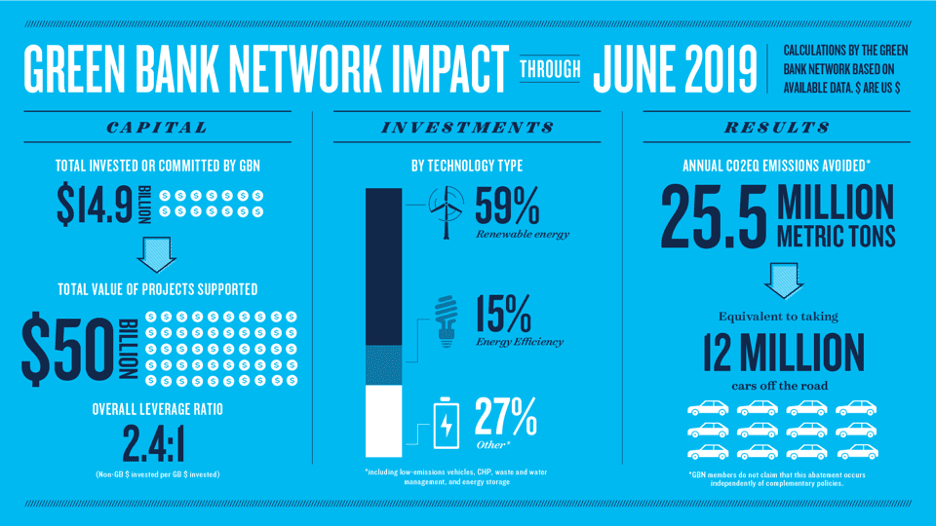Building column on a government building with a beautiful blue sky.

Green Banks 101
Countries around the world have committed to undertake ambitious climate action as part of the Paris Agreement. However, development of climate solutions cannot be solely dependent on limited concessional funds from multilateral institutions. Instead, they must be country driven and enabled by local ownership that drives investment and attracts both domestic and private capital. That’s where green banks come in.
With their mandate to focus on low-carbon, climate-resilient investments and crowd in private capital, green banks are ideally positioned to assist countries with the implementation of their nationally determined contributions (NDCs), as per the terms of the Paris Agreement.
What Are Green Banks?
Green investment banks are typically public or quasi-public entities, initially capitalized with public funds. These entities are dedicated to leveraging those public funds to attract larger amounts of private capital to invest in green projects, thus creating jobs and building a resilient economy.
Green banks vary in structure and execution across the world, yet there are some common principles that define a green bank. Those characteristics are:
- A narrow but flexible mandate focusing on low-carbon, climate-resilient investments
- Independence
- Additionality through focus on market gaps (crowding in, never crowding out private investors)
- Accountability through measurement of impact metrics such as jobs created, private capital mobilized, return on capital, and greenhouse gas reductions achieved
- Capitalization with at least some public funds
- Removing barriers to low-carbon, climate-resilient investments to help achieve local climate and development objectives
- Designed in service of leveraging private capital
There are currently nine existing, fully fledged green banks that are members of the Green Bank Network, a professional “guild” of green banks. There are also some green banks that are not members of the Green Bank Network (e.g., those established by Montgomery County, Maryland and Norway, New Zealand Green Investment Finance and the Development Bank of Southern Africa Clean Finance Facility), as well as many green banks in various stages of development globally.
An Institutional Solution to the Climate Crisis
Green banks help countries reach their climate goals by scaling up and deploying low-carbon investment, while building financial capacity to crowd in the private sector in critical markets. They act as a catalyst within the markets in which they operate, providing financial tools as well as guidance for existing public and private financial institutions to meet their green portfolio mandates. They help develop local capital markets, mobilize domestic pension funds, and design localized solutions to complement development finance and foreign direct investment. Finally, green banks can help countries achieve their NDCs by turning theoretical plans into concrete, funded green projects.
Green banks also help address real and perceived market gaps where critically important climate investments lack the scale, financial returns, or maturity for commercial financing. For example, it might be difficult for private investors to provide capital at rates necessary for a project to succeed because they perceive the investment as risky. This may be because the project relies on an unproven technology, because the investor would be the first mover in the space, or because the underlying customers are considered a credit risk.
Green banks can accelerate deployment of new technology and business models by blending concessional capital with private investment to bring down the overall cost of capital and mitigate downside risks to private investors. And green bank investments are not limited to renewable energy: they can include electric vehicles, municipal waste, retirement of uncompetitive coal plants, energy efficiency, and many other decarbonization projects. In other words, due to their flexible yet dedicated mandate, green banks can invest in any critical green projects in jurisdictions in which they operate.
Beyond Traditional Institutions
Even in countries with a deep financial sector capable of attracting domestic and international finance for infrastructure, the creation of a financial institution with a dedicated mandate can advance entire low-carbon sectors and value chains at a rate far exceeding traditional institutions.
For example, the UK government’s creation and seed funding of the UK Green Investment Bank expanded investment in low-carbon sectors that were underinvested in by the private sector. The bank invested in energy efficiency, anerobic digestion, waste-to-energy, and offshore renewables—all while leveraging £4 of private investment for every £1 of public funds invested. Notably, prior to being sold to the Macquarie Group in 2017, the UK Green Investment Bank made critical investments in the UK’s offshore wind sector, leading to the country becoming a global leader in the offshore wind market.
Similarly, countries with existing national development banks can benefit from establishing a green bank or facility because of their dedicated mandate, green finance expertise, and ability to focus on critical sectors.
How Green Banks Work
Green banks do what they do using innovative financial instruments. Projects promoting new and less-established clean technologies often have trouble accessing credit and investment because they require non-traditional financing structures; these projects need specific financial tools to get underway. Often, the problem lies in small project sizes or a need for longer tenors that private investors may not be willing to offer on their own. For example, the UK Green Investment Bank helped increase the penetration of LED technology in street lighting by offering local authorities low, fixed-rate loans over a period of 20 years.
In other words, green banks create new opportunities for private investment by using financial tools to reduce real or perceived risk. In this way, green banks spur more overall investment and multiply the impact of their initial capitalization. These tools include:
- Co-lending/financing (debt and equity)
- Risk mitigation and credit enhancement (guarantees, first loss, green bonds)
- Innovative financing (tax credits, lien-based financing)
- Debt forgiveness for decarbonization, etc.
Green Banks Around the World
Green banks have a place in developed countries, emerging markets, and developing countries. For example, Australia’s Clean Energy Finance Corporation (CEFC) lends money at risk-adjusted terms to projects across Australia that help develop or commercialize clean energy technologies. As of June 2018, CEFC had directly invested in more than 110 individual transactions, financed more than 5,500 smaller-scale clean energy projects through partners, and estimates it will help avoid the equivalent of more than 190 million tons of CO2.
In India, Tata Cleantech Capital Limited (TCCL), which calls itself a “non-banking finance company,” uses private funds to create an ecosystem that encourages private investors to come in at scale. In the past six years, TCCL has funded about $1.25 billion of both large utility-scale solar and wind projects and smaller energy efficiency, hydro, and rooftop solar projects.
Mongolia is another example, and the Mongolian Green Finance Corporation (MGFC) is being established as a public-private institution championed by the Mongolia Bankers Association. MGFC will be an institution focused on engaging commercial banks in low-carbon projects in Mongolia.
In countries, provinces, and municipalities around the world, green banks have emerged as one of the best ways to increase the volume and efficiency of green investment in order to achieve national and global climate targets. Green banks have the expertise and mandate to unlock private investment for low-carbon development on the scale need to address the climate emergency.


